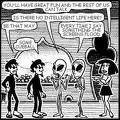Will Eisner (1917-2005) was a great cartoonist, but he was also a shrewd businessman with his finger on the throbbing erratic pulse of popular culture trying to predict, maneuver, and exploit the next trend given his very specific set of skills. He spent his life wrestling with those demanding twins, Art and Commerce.
In 1936 when he was 19 Eisner had his first professional work published in "WOW What A Magazine!", one of the first comic books to publish new work in the format we are familiar with today. As he put it in an interview in 1984, "Pulp magazines were dying and pulp publishers were looking for other popular publishing ventures, and so comics represented that opportunity."
Eisner himself never missed an opportunity. Overnight dozens of new comic book titles and publishers erupted to mine the bonanza begun by the 1938 publication of Superman in Action Comics. Simultaneously all these publishers were putting out beefy 52 page comic books. They needed stories and art and they needed them last week.
Eisner and his partner, Jerry Iger, formed a company to package the guts of comic books and sell them to various publishers based on a very simple and sound method perfected by Henry Ford: the assembly line. Each page in the bullpen studio was literally handed from writer, to penciler, to letterer, to inker, to colorist with Eisner gripping his non-repro blue pencil at the end of the conveyor belt.
His works are very good :)


























